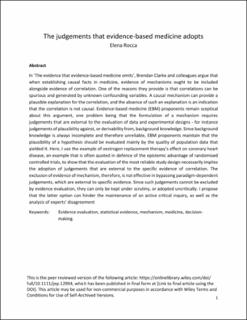| dc.contributor.author | Rocca, Elena | |
| dc.date.accessioned | 2020-12-01T16:17:17Z | |
| dc.date.available | 2020-12-01T16:17:17Z | |
| dc.date.created | 2018-06-25T13:49:19Z | |
| dc.date.issued | 2018 | |
| dc.identifier.citation | Journal of Evaluation In Clinical Practice. 2018, 24 (5), 1184-1190. | en_US |
| dc.identifier.issn | 1356-1294 | |
| dc.identifier.uri | https://hdl.handle.net/11250/2711305 | |
| dc.description.abstract | In ‘The evidence that evidence-based medicine omits’, Brendan Clarke and colleagues argue that when establishing causal facts in medicine, evidence of mechanisms ought to be included alongside evidence of correlation. One of the reasons they provide is that correlations can be spurious and generated by unknown confounding variables. A causal mechanism can provide a plausible explanation for the correlation, and the absence of such an explanation is an indication that the correlation is not causal. Evidence-based medicine (EBM) proponents remain sceptical about this argument, one problem being that the formulation of a mechanism requires judgements that are external to the evaluation of data and experimental designs - for instance judgements of plausibility against, or derivability from, background knowledge. Since background knowledge is always incomplete and therefore unreliable, EBM proponents maintain that the plausibility of a hypothesis should be evaluated mainly by the quality of population data that yielded it. Here, I use the example of oestrogen replacement therapy’s effect on coronary heart disease, an example that is often quoted in defence of the epistemic advantage of randomised controlled trials, to show that the evaluation of the most reliable study design necessarily implies the adoption of judgements that are external to the specific evidence of correlation. The exclusion of evidence of mechanism, therefore, is not effective in bypassing paradigm-dependent judgements, which are external to specific evidence. Since such judgements cannot be excluded by evidence evaluation, they can only be kept under scrutiny, or adopted uncritically. I propose that the latter option can hinder the maintenance of an active critical inquiry, as well as the analysis of experts’ disagreement | en_US |
| dc.description.abstract | The Judgements That Evidence Based Medicine Adopts | en_US |
| dc.language.iso | eng | en_US |
| dc.rights | Attribution-NonCommercial-NoDerivatives 4.0 Internasjonal | * |
| dc.rights.uri | http://creativecommons.org/licenses/by-nc-nd/4.0/deed.no | * |
| dc.title | The Judgements That Evidence Based Medicine Adopts | en_US |
| dc.type | Peer reviewed | en_US |
| dc.type | Journal article | en_US |
| dc.description.version | acceptedVersion | en_US |
| dc.source.pagenumber | 1184-1190 | en_US |
| dc.source.volume | 24 | en_US |
| dc.source.journal | Journal of Evaluation In Clinical Practice | en_US |
| dc.source.issue | 5 | en_US |
| dc.identifier.doi | 10.1111/jep.12994 | |
| dc.identifier.cristin | 1593686 | |
| dc.relation.project | Norges forskningsråd: 240073 | en_US |
| cristin.unitcode | 192,11,0,0 | |
| cristin.unitname | Handelshøgskolen | |
| cristin.ispublished | true | |
| cristin.fulltext | postprint | |
| cristin.qualitycode | 1 | |

